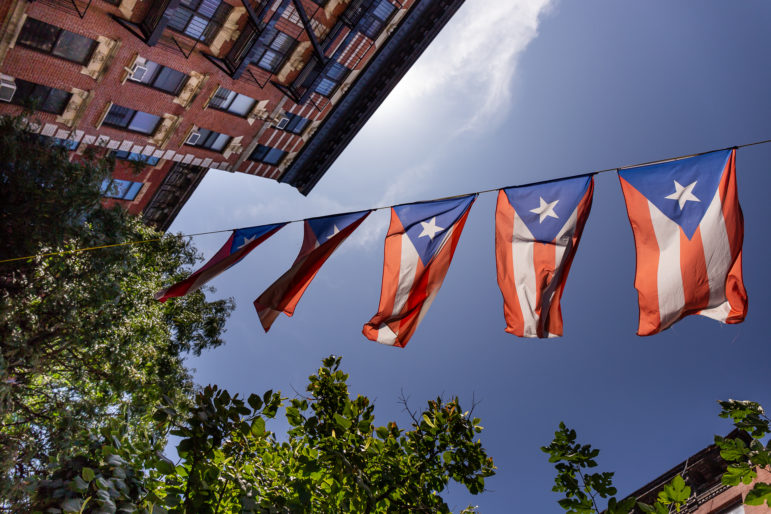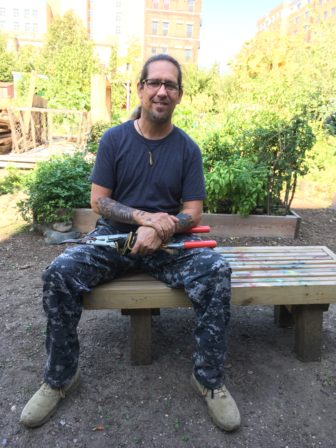
Adi Talwar
The number of displaced Puerto Ricans or Puerto Rican families served by the city also remains unknown.
Una versión en español está aquí.
Rainbow Garden of Life and Health is like an island, a green dot surrounded by waves of buildings in Melrose, the Bronx. A green island that reminds Rafael Ocasio Barreto, activist and community leader, of the kind of green he used to see in his native Puerto Rico. He came two years ago after Hurricane Maria drowned that island. “I left without being able to see the green of the island. Everything was flooded. And here everything was white and cold,” he says.
Two years after Hurricane Maria, neither the mayor’s office nor the Federal Emergency Management Agency, FEMA, knows how many Puerto Ricans displaced by the storm remain in the city. FEMA told City Limits that “a more detailed look at the NYC aspects/impacts” would “best be handled by the city.” However, neither the mayor’s office nor several of the city’s agencies were able to say.
The number of displaced Puerto Ricans or Puerto Rican families served by the city also remains unknown. Ocasio Barreto arrived in New York City in November 2017. Since then, he has guided more than 160 Puerto Rican families to find aid offered by the government and nongovernmental organizations.
From October 19, 2017 to February 12, 2018, New York City operated a service center at the Julia de Burgos Latino Cultural Center in which, according to an email from the city, “more than 2,500 households” were connected to services such as health insurance, food assistance, mental health and emotional health. But after roughly four months “the operation moved to agency-based services” and the possibility of tracking this diaspora as a group was lost.
Some evidence does exist of a modest influx to the city. According to Peter Gudaitis, executive director of New York Interfaith Disaster Services, NYDIS, there are about 200 displaced Puerto Rican families living in city shelters.
The city’s Department of Education (DOE) does not report “a significant increase” in the number of students enrolled following Maria, although they are unable to estimate the number of storm-related Puerto Rican enrollments because the DOE does not track “the reason for enrollment” of students.
The school-related data that is available for new York is statewide. According to a study by the Center for Puerto Rican Studies at the City University of New York, 2,218 new Puerto Rican students in grades K-12 were enrolled in the state, representing a total increase of 1percent since 2015. Overall, “displaced students enrolled in New York City school districts remained at 411 between both periods,” reads the report.
“One of the reasons why Puerto Rican families with school-age children settled in New York after the hurricane was access to education,” says Ocasio Barreto. Around 265 public schools in Puerto Rico—24percent of the total—closed after Hurricane Maria. The lack of schools and teachers became one of the decisive factors for families to remain in the continental United States. In New York, 40 percent of the population that relocated here settled in the Bronx, followed by 30 percent in Manhattan, according to NYDIS data.

Daniel Parra
Rafael Ocasio Barreto
According to Victor Martinez, co-founder of Diaspora for Puerto Rico, the relocation of people took multiple routes. “ome went to shelters, others to apartments, others never asked for help, others moved out of the state—because New York is expensive—and others simply returned to the island,” he says.
According to the U.S. Census Bureau, the population in Puerto Rico decreased by 129,848 people from July 1, 2017 to July 1, 2018, although that drop could include people who left for reasons other than the hurricane, which struck on September 20, 2017.
But understanding the hurricane’s impact on the city’s Puerto Rican community is not just about the tally of people who came to the five boroughs after the storm. It also involves the number of Puerto Ricans who would otherwise have moved back from the city to the island, but did not.
From 2017 to 2018, “an estimated 25,000 people returned to Puerto Rico” from New York, explains Carlos Vargas, a researcher at the Center for Puerto Rican Studies at the City University of New York. “That is return migration and its numbers have been declining since the 2006 financial crisis in Puerto Rico,” he says.
On the island, the poverty rate stands at 44 percent According to Gretchen Sierra-Zorita, communications strategist for the Puerto Rican National Agenda, “the hurricane has worsened the vicious circle of greater poverty, fewer jobs, and more people wanting to leave.”
Of the $42.30 billion in funds allocated to Puerto Rico by the federal government in disaster assistance, only $20.37 billion has been obligated and only $12.62 billion has been disbursed. In addition, the Trump administration has imposed restrictions of approximately $8.3 billion on disaster mitigation funds for housing and urban development, and the Department of Homeland Security said it will transfer $271 million from FEMA’s fund to the Immigration and Customs Enforcement Agency to buy new beds in detention centers, among other things. FEMA has also admitted that 62 percent of Puerto Ricans’ requests to repair their homes were rejected or are “in process.” Thus, “Puerto Rico was forgotten because money has been taken out from the victims,” says Jaime Estades, executive director of the Latino Leadership Institute.
Some have labeled the combination of crushing debt and paltry storm response as a “slow genocide.” If there is one thing that academics, social leaders, journalists and nonprofits on and off the island agree on, it is that the federal response was a disaster in itself. “For many people, the hurricane has not yet passed. The nightmare continues,” says Natasha Lycia Ora Bannan, associate counsel at Latino Justice.
“In Puerto Rico, people believe we are having a great time in the United States but that’s not the case,” says Ocasio Barreto. “Here, people also struggle.” There are Puerto Rican families living in New York who cannot return to the island because they have no place to live, or they have no money to pay for the tickets, or dare not depend on the medical system there to treat serious diseases. The number are fuzzy but reality isn’t. “Both here in New York and there in Puerto Rico, people survive,” Ocasio Barreto says.
If you came to New York City because of Hurricane Maria, we would like to hear about your story and experience. Please email us at daniel@citylimits.flywheelstaging.com








